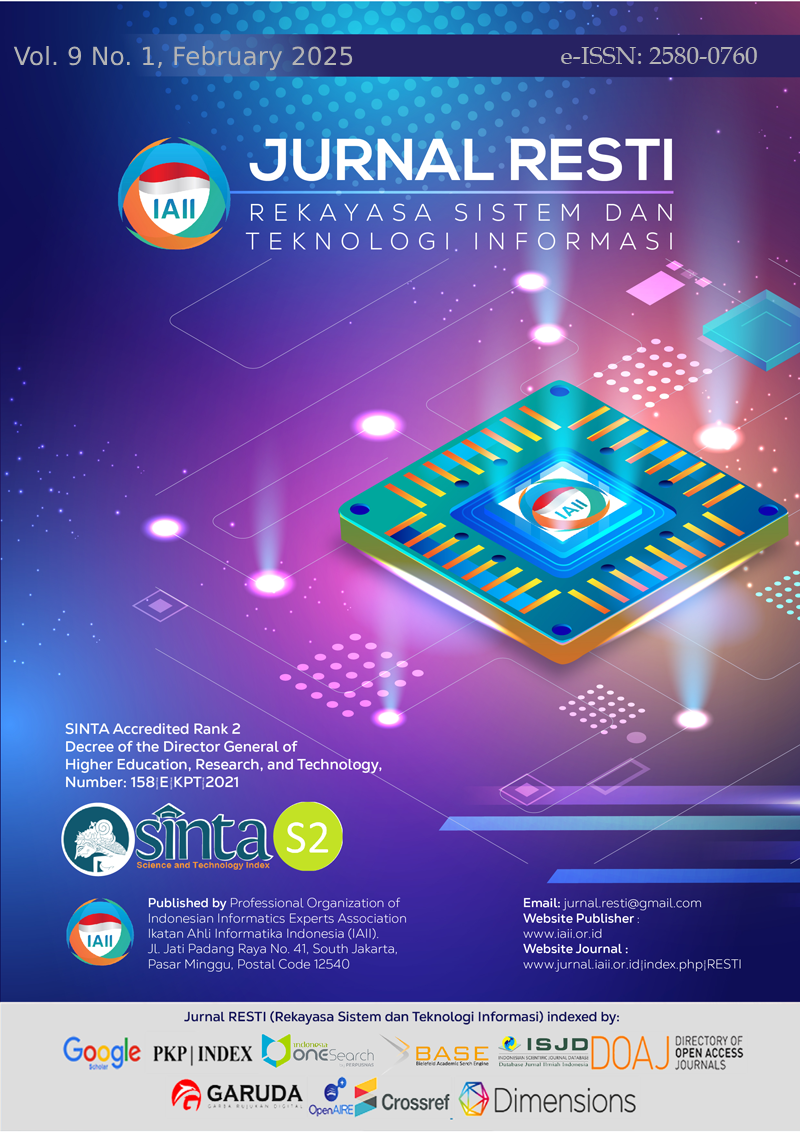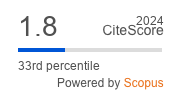Impact of XBRL Technology Implementation on Information Asymmetry in Indonesia’s Capital Market
Abstract
This research aims to examine whether the publication of financial statements in XBRL format could reduce the level of information asymmetry, measured by the bid-ask spread, in Indonesia’s capital market over eight years of its implementation. Furthermore, this research examines differences in the level of information asymmetry in two observation periods, which are the early stage and the advanced stage of the XBRL implementation. The population in this study are listed companies on the IDX80 index which were sampled using the purposive method. The analytical instrument used is a panel data regression test using a random effect model and the non-parametric Wilcoxon test of statistical differences. Consistent with similar studies, the results show that the publication of financial reports in XBRL format could reduce the level of information asymmetry by providing accurate, integrated, and universally accessible reporting. The difference test further reveals that the level of information asymmetry is lower in the advanced stages compared to the early stages. This suggest that XBRL implementation becomes more effective over time due to the positive developments in institutional readiness and stakeholder facilitation.
Downloads
References
H. Isidro, D. Nanda, PD. Wysocki, “On the relation between financial reporting quality and country attributes: Research challenges and opportunities”, The Accounting Review, vol.95, no. 3, pp. 279-314, 2020, doi: 10.2308/accr-52607.
N. Juhandi, M. Fahlevi, I. Purnamawati, DD. Kesa, B. Setyawan, HA. Tantriningsih, “XBRL: The New E-Language of Financial Digital Reporting in Indonesia”, Journal of Management Information & Decision Sciences, vol. 25, no. 1, pp. 1-8, 2022.
B. Wang, D. Wang, "A Process Model for XBRL Taxonomy Development", Journal of Signal Processing Systems, vol. 90, no. 8, pp. 1213-1220, 2018, doi: 10.1007/s11265-017-1311-1.
F. Frista, S. Utama, SV. Siregar, “The Effect of eXtensible Business Reporting Language (XBRL) Adoption on Earnings Management: Empirical Evidence from an Emerging Country”, In Contemporary Issues in Financial Economics: Evidence from Emerging Economies, vol. 37, pp. 97-115, 2023, doi: 10.1108/S0196-382120230000037006.
Z. Sanad, A. Al-Sartawi, “A Broader Perspective on eXtensible Business Reporting Language (XBRL) in Earnings Management Research”, In European, Asian, Middle Eastern, North African Conference on Management Information Systems, vol. 557, pp. 435-446, 2023, doi: 10.1007/978-3-031-17746-0.
V. Tohang, A. Limijaya, M. Chitrahadi, “An Analysis of the Impact of XBRL Filings towards Information Asymmetry in Indonesia”, In 2020 International Conference on Information Management and Technology (ICIMTech), pp. 330-335, 2020, doi: 10.1109/ICIMTech50083.2020.9211114.
S. Chen, J. Guo, Q. Liu, X. Tong, “The Impact of XBRL on Real Earnings Management: Unexpected Consequences of the XBRL Implementation in China", Review of Quantitative Finance and Accounting, vol. 56, no. 2, pp. 479-504, 2021, doi: 10.1007/s11156-020-00900-1S.
Muthalia D, Kurniasari F, Prihanto JN, “XBRL Adoption of Information Asymmetry in Manufacturing Company”, United International Journal for Research & Technology, vol. 3, no. 1, pp. 100-105, 2021.
V. Tohang, J. Andika, “The Impact of XBRL Filings towards Information Asymmetry: A Comparison between Mandatory and Voluntary XBRL Implementation”, PalArch's Journal of Archaeology of Egypt/Egyptology, vol. 17, no. 7, pp. 2487-2498, 2020.
A. G. Mayapada, M. Afdhal, & R. Syafitri, “Earnings Management in the Pre and Post eXtensible Business Reporting Language Period in Indonesia”, The Indonesian Journal of Accounting Research, vol. 23, no. 1, pp. 29-48, 2020, doi: 10.33312/ijar.459.
SU. Sasmita, A. Saebani, A. Setiawan, “Pengaruh Adopsi XBRL dan Ukuran Perusahaan terhadap Risiko Informasi”, Konferensi Riset Nasional Ekonomi Manajemen dan Akuntansi. vol. 2, no. 1, pp. 126-39, 2021.
E. Putra, M. Mahdahleni, MM. Desda, “Influence of Stock Trading Volume and Company Size on Stock Price Volatility in IDX80 Banking Companies During The Covid-19 Pandemic", Jurnal Ekonomi Sean Institute, vol. 11, no. 3, pp. 2055-2068, 2022.
S. Suprihatin, E. Tresnaningsih, “Dampak konvergensi international financial reporting standards terhadap nilai relevan informasi akuntansi”, Jurnal Akuntansi dan Keuangan Indonesia (JAKI), vol. 10, no. 2, pp. 171-183, 2013. doi: 10.21002/jaki.2013.09.
HR. Stoll, “Inferring the components of the bid‐ask spread: Theory and empirical tests”, The Journal of Finance, vol 44, no. 1, pp. 115-134, 1989, doi: 10.1111/j.1540-6261.1989.tb02407.x.
N. Febrianti, “Analisis Perbedaan Bid Ask Spread dan Volatilitas Saham Sebelum dan Sesudah Pengumuman Stock Split”, BISMA (Bisnis dan Manajemen), vol. 7, no. 1, pp. 17-25, 2022. doi: 10.26740/bisma.v7n1.p17-25.
S. Sulistyanto, “Manajemen Laba (Teori & Model Empiris)”, Jakarta: Grasindo, 2008.
A. Field, “Discovering Statistics Using SPSS (3rd ed.)”, New York: Sage Publications Ltd, 2009.
HA. Ryan, “The Use of Financial Ratios as Measures of Risk in the Determination of the Bid-Ask Spread”, Journal of Financial and Strategic Decisions, vol. 9, no. 2, pp. 33-41, 1996.
A. Mashuri, "Buku Ajar Statistika Parametrik Dasar: Uji Hubungan, Uji Perbedaan, dan Aplikasinya Menggunakan JASP", Malang: Inara Publisher, 2023.
S. Lambert, K. Krieger, N. Mauck, "Analysts' Forecast Timeliness and Accuracy Post-XBRL", International Journal of Accounting Information Management, vol. 27, no. 1, pp. 151-188, 2019, doi: 10.1108/IJAIM-05-2017-0061.
G. Chen, X. Wang, J. Zhou, "What Do the Markets Say? Shareholder Wealth Effects of the XBRL Mandate", Journal of Information System, vol. 32, no. 3, pp. 1-21, 2018, doi: 10.2308/isys-51814.
T. Dunne, C. Helliar, A. Lymer, R. Mousa, “Stakeholder Engagement in Internet Financial Reporting: The Diffusion of XBRL in the UK, The British Accounting Review, vol. 45, no. 3, pp. 167-182, 2013, doi: 10.1016/j.bar.2013.06.012.
F. Amalia, O. Yigitbasioglu, S. Tooley, "The Institutionalisation of XBRL in a Developing Capital Market: the Indonesian Regulators’ and Filers’ Perspective", Qualitative Research in Accounting & Management, vol. 21, no. 4, 2024, doi: 10.1108/QRAM-12-2022-0209.
A. Ayoub, P. A. R. Vidyasagar, & H. Luong, "Human Factors Affecting XBRL Adoption Success in Lebanese Small to Medium-Sized Enterprises", Big Data and Security: First International Conference, ICBDS, pp. 98–115, 2020, doi: 10.1007/978-981-15-7530-3_8.
B. Hinings, T. Gegenhuber, R. Greenwood, "Digital Innovation and Transformation: An Institutional Perspective", Information and Organization, vol. 28, no. 1, pp. 52-61, 2018, doi: 10.1016/j.infoandorg.2018.02.004.
D. Garner, D. Henderson, SD. Sheetz, BS. Trinkle, “The Different Levels of XBRL Adoption”, Management Accounting Quarterly, vol.14, no. 2, pp.1-10, 2013.
Copyright (c) 2025 Jurnal RESTI (Rekayasa Sistem dan Teknologi Informasi)

This work is licensed under a Creative Commons Attribution 4.0 International License.
Copyright in each article belongs to the author
- The author acknowledges that the RESTI Journal (System Engineering and Information Technology) is the first publisher to publish with a license Creative Commons Attribution 4.0 International License.
- Authors can enter writing separately, arrange the non-exclusive distribution of manuscripts that have been published in this journal into other versions (eg sent to the author's institutional repository, publication in a book, etc.), by acknowledging that the manuscript has been published for the first time in the RESTI (Rekayasa Sistem dan Teknologi Informasi) journal ;








